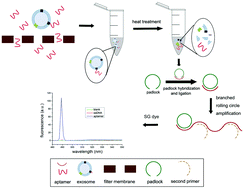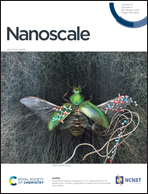A simple fluorescence aptasensor for gastric cancer exosome detection based on branched rolling circle amplification
Abstract
Exosomes are membrane nanovesicles carrying molecular information that may reflect the biological and genetic characteristics of their parent cells. Numerous studies have demonstrated the potential of exosomes as noninvasive cancer biomarkers. Hence, specific detection of cancer cell-derived exosomes is of significant importance. Here, we developed a fluorescence assay for the determination of gastric cancer exosomes based on branched rolling circle amplification (BRCA) and an aptamer to target specific exosomes. The designed padlock probe was cyclized after incubation with an aptamer binding with the target exosome. BRCA was triggered by adding a second primer and the resulting long tandem double-stranded DNA product was detected using SYBR Green I as the fluorescent dye. This method demonstrated a high specificity for target exosomes with a detection limit of 4.27 × 104 exosomes per mL. Moreover, plasma from gastric cancer patients was tested to verify the clinical applicability of this assay. Our results demonstrated that this aptamer-based biosensor may show potential for the early diagnosis of gastric cancer.

- This article is part of the themed collection: Nanoscale 2021 Lunar New Year Collection


 Please wait while we load your content...
Please wait while we load your content...